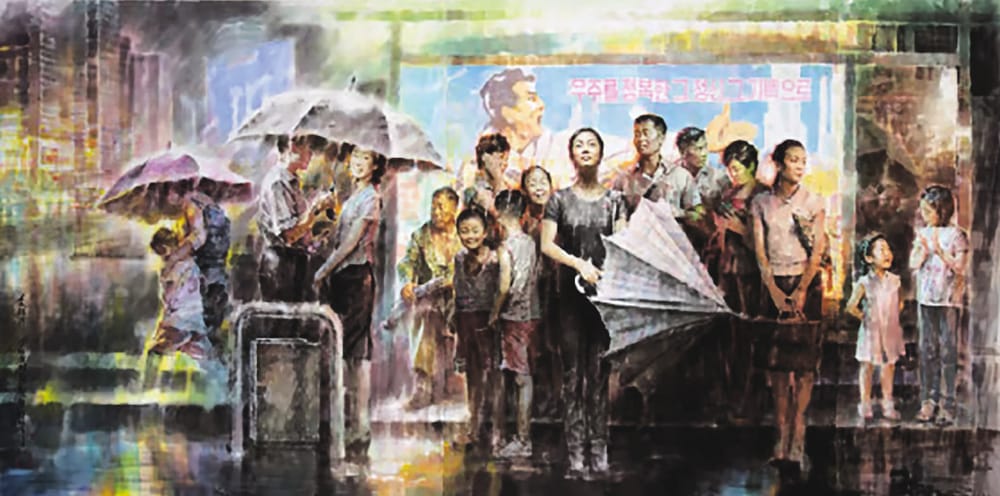It’s customary to begin writing on North Korea by acknowledging how difficult it is to get reliable information from such a secretive and tightly-controlled regime in such a highly politicized context. Though an undoubtedly repressive regime, in an information vacuum misinformation can spread, such as the easily-disproved but persistent misconception that all North Korean citizens must sport the same distinctive hairstyle as their leader Kim Jong-un.
Hidden Heroes’ co-editors Immanuel Kim and Benoit Berthelier are scholars of North Korea and have spoken of repeatedly encountering the misconception that all North Korean literature revolves around praise of the supreme leader. North Korean literature is released through official channels (these stories were chosen primarily from Choson Munhak and Munhak Sinmun, the two main literary journals in North Korea) and is undoubtedly propaganda. However, as Berthelier and Kim hope to show, it’s not as simple as relentless praise of the supreme leader.
While the most internationally-famous North Korean film Pulgasari (made by filmmaker Shin Sang-ok in 1985) features a Godzilla-like monster, the stories in Hidden Heroes are resolutely everyday. As the editors make clear with their title, modern North Korean short stories extol the virtues of “hidden heroes”: ordinary people: factory workers, miners—female characters are often prominent—who show extraordinary loyalty or tenacity.
Hidden Heroes offers anglophone readers a snapshot of the lives of everyday people in North Korea.

The leader receives praise in one of the ten stories collected here, but otherwise he is not mentioned. The propaganda comes from the hidden heroes themselves, people willing to sacrifice something for a greater good, or to do the right thing under pressure. This sacrifice does not have to be existential: in Paek Namnyong’s “Life”, a Dean feels pressure to admit to his university the son of a doctor who had once saved his life. This would mean rejecting the application of a higher achieving student. North Korean literature celebrates small victories and virtuous, altruistic actions.
Surprisingly, cigarettes and alcohol are frequently mentioned, the latter functioning as a social lubricant and—like in South Korea—pouring drinks for elders is a sign of respect. In a further surprise, In Kim Chŏng’s “Seventeen People’s Laughter”, a male worker dresses up as a female figure skater as part of a comedy performance. Teenagers blast music from their boomboxes at obnoxious volumes. Some of the details in Much of the Hidden Heroes are recognizable, ordinary, but are sometimes surprising to see in the North Korean context.
Probably the most interesting story is Kwang Kwimi’s “The Actor’s Last Class” which uses the zainichi, Koreans living in Japan, as its backdrop. From 1959 to 1984, North Korea ran a project to encourage Koreans living abroad to emigrate to North Korea. Kang’s story is part of the propaganda for this programme, and uses Rembrandt’s famous painting The Return of the Prodigal Son to give the repatriation movement a Biblical sense of destiny.
It’s impossible not to wonder what the appeal of these particular stories must be in a culture so vastly different.
Kim and Berthelier chose pieces that were popular with audiences in North Korea. Knowing this, it’s impossible not to wonder what the appeal of these particular stories must be in a culture so vastly different, and where official literature is narrowly defined. In Kim Myŏngjin’s “Face”, two inseparable male friends are given the nicknames “bride” and “groom”. Are North Korean audiences reading against the grain and enjoying a possible homosexual subtext, or do these appellations have no such connotations in North Korea?
The contextual material supplied by Kim and Berthelier is helpful, beginning with musings on what realism is and moving to a discussion of how the ten pieces collected here were selected, before finally noting that editing in North Korea is usually limited to an ideological capacity and does not aim to make text more readable and flowing. Each writer also gets a capsule biography
Though the stories of Hidden Heroes do not have much immediate literary or entertainment value, this is not the purpose of the anthology. Hidden Heroes offers anglophone readers a snapshot of the lives of everyday people in North Korea. It gives a clearer picture of the regime: the leader is not constantly praised, and corruption and the famine of the 1990s can, it seems, be publicly acknowledged. The primary audience for this volume though, is likely to be those interested in the minutiae of North Korean life and politics, and scholars interested in the mechanisms of literary propaganda.


You must be logged in to post a comment.